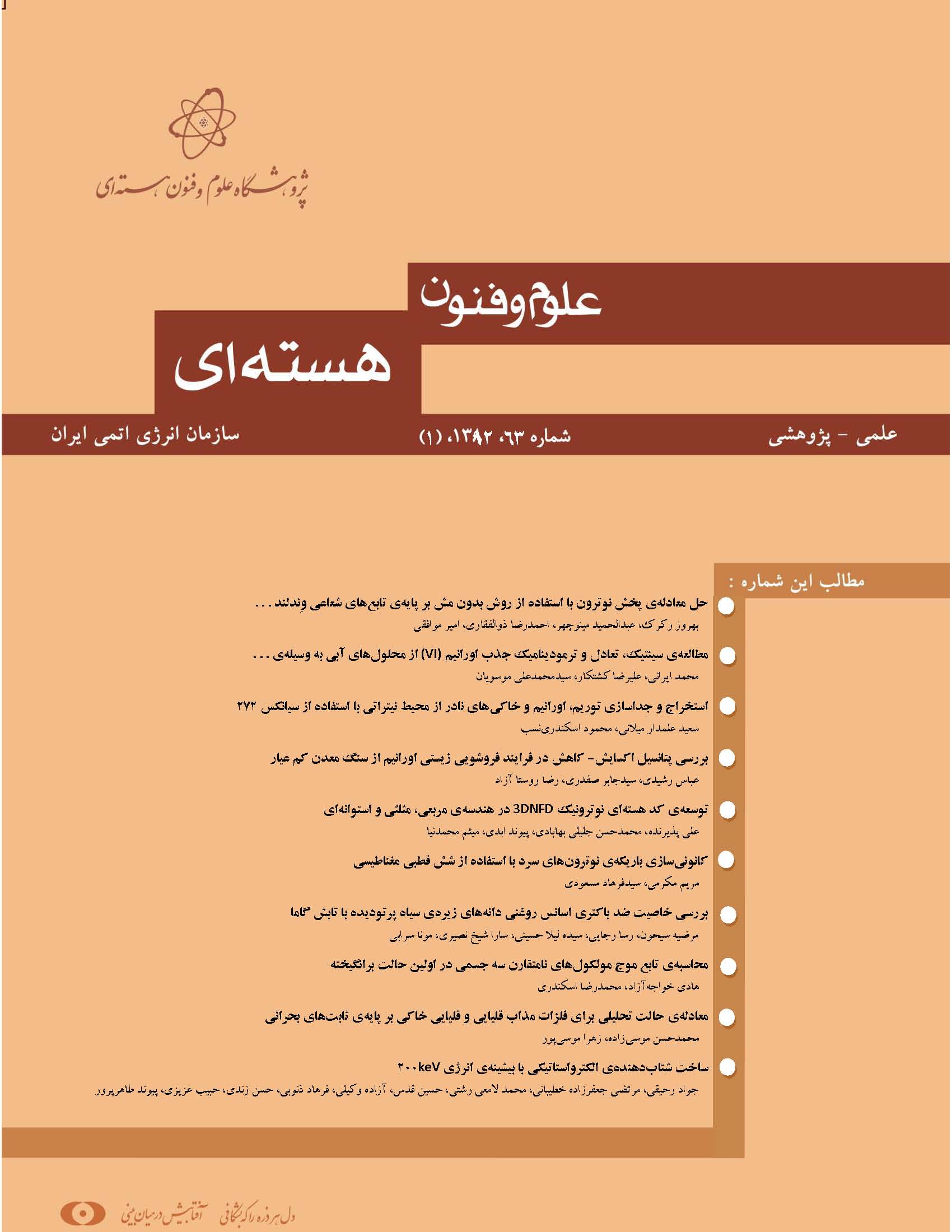نوع مقاله : مقاله پژوهشی
نویسندگان
1 . پژوهشکدهی چرخهی سوخت، پژوهشگاه علوم و فنون هستهای، سازمان انرژی اتمی ایران، صندوق پستی: 8486-11365، تهران ـ ایران 2. دانشکدهی مهندسی شیمی و نفت، دانشگاه صنعتی شریف، صندوق پستی: 9465-11365، تهران ـ ایران
2 پژوهشکدهی چرخهی سوخت، پژوهشگاه علوم و فنون هستهای، سازمان انرژی اتمی ایران، صندوق پستی: 8486-11365، تهران ـ ایران
3 دانشکدهی مهندسی شیمی و نفت، دانشگاه صنعتی شریف، صندوق پستی: 9465-11365، تهران ـ ایران
چکیده
پتانسیل اکسایش- کاهش در فرایند فروشویی زیستی اورانیم از سنگ معدن کمعیار به وسیلهی باکتری اسیدی تیوباسیلوس فرواکسیدان در شرایط مختلف به روش تجربی اندازهگیری شد. نتایج تجربی به دست آمده، با مدل پتانسیل ترکیبی به دست آمده از معادلهی باتلر- والمر برازش شدند. نتایج برازش نشان داد که این مدل برای پیشبینی پتانسیل اکسایش- کاهش محلول در فروشویی زیستی اورانیم از سنـگ معـدن آنومالی 1 ساغند از دقت بسیار بالایی برخوردار بوده و درصد خطای نسبی حاصل از به کارگیری این مدل در فرآوری سنگ معدن استفاده شـده، کمتـر از %4 است. مقدارهای میـانگین ثابتهای km/kα، kc/kα و b (مربوط به نرخهای الکتروشیمیایی) در آزمایشهای با چگالی پالپ 5 و %10 به ترتیب، برابر 260، 30606، و 0.01 به دست آمد. مقایسهی نتایج تجربی به دست آمده از رابطهی نرنست برای دو حالت با ضریبهای فعالیت برابر با و مخالف یک نشان داد که درصد خطای نسبی حاصل از به کارگیری رابطهی نرنست برای حالت اول (1=γi) کمتر از %45 و برای حالت دوم (1≠γi) کمتر از %35 است.
کلیدواژهها
عنوان مقاله [English]
Study of Oxidation-Reduction Potential in Uranium Bioleaching from a Low Grade Ore
نویسندگان [English]
- A Rashidi 1
- S.J Safdari 2
- R Roosta-Azad 3
چکیده [English]
Oxidation-reduction potential (ORP) in uranium bioleaching from a low grade ore by Acidithiobacillus ferrooxidans is measured experimentally under different conditions. The experimental results are fitted to the mixed potential model, obtained from Butler-Volmer equation. The results from this fitting showed that the model predictes the ORP in uranium bioleaching from 1th anomaly of Saghand ore with very high accuracy the relative error of the present applied model in the process of the used ore is less than 4%. The average values of the electrochemical rates constants km/kα, kc/kα and b related to the experiments with the pulp density of 5% and 10% (w/v) were obtained to be 260, 30606 and 0.01 respectively. The experimental results were also compared with the Nernst equation prediction for two cases of γi=1, γi≠1. The results showed that the relative error of this model is less than 45% with activity coefficients equal to one and less than 35% with real activity coefficients.
کلیدواژهها [English]
- Oxidation-Reduction Potential
- Bioleaching
- Acidithiobacillus Ferrooxidans
- Uranium
- 1. G. Rossi, Biohydrometallurgy, McGraw-Hill, New York (1990).
- 2. I. G. Petrisor, I. Lazar, T. F. Yen, Bacterial mining, Petroleum Science and Technology, 25 (2007) 1347-1352.
- 3. M. J. Crawford, Mining technologies for the new millennium, Mining Voice, 5(5) (1999) 28-34.
- 4. IAEA Technical Report No. 359, Uranium extraction technology, International Atomic Energy Agency, Vienna (1993).
- 5. P. A. Laxen, Fundamental study of the dissolution in acid solutions of uranium minerals from South African ores, National Institute for Metallurgy, South Africa (1973).
- 6. G. Sommer, G. T. W. Omrod, R. P. Chaix, Recent developments in the instrumentation and automation of uranium processing plants, J. S. Afr. Inst. Min. Metall., 74 (1973) 413-420.
- 7. E. R. Donati, W. Sand, (Eds.), Microbial Processing of Metal Sulfides, Springer, Netherlands (2007).
- 8. A. J. H. Janssen, S. Meijer, J. Bontsema, G. Lettinga, Application of the redox potential for controling a sulfide oxidizing bioreactor, Biotechnology and Bioengineering, 60 (2) (1998) 147-155.
- 9. S. Molchanov, Y. Gendel, I. Ioslvich, O. Lahav, Improved experimental and computational methodology for determining the kinetic equation and the extant kinetic constants of Fe(II) oxidation by Acidithiobacillus ferrooxidans, Applied and Environmental Microbiology, 73 (6) (2007) 1742-1752.
- 10. K. Penev, D. Karamanev, Batch Kinetics of ferrous iron oxidation by Leptospirillum ferrooxidans at moderate to high total iron concentration, Biochemical Engineering Journal, 50 (2010) 54-62.
- 11. A. P. Chandra, A. R. Gerson, (Review) The mechanisms of pyrite oxidation and leaching: A fundamental perspective, Surface Science Reports, 65 (2010) 293-315.
- 12. J. Newman, K. E. Thomas-Alyea, Electrochemical systems, Third Ed., John Wiley & Sons, Inc., New York (2004).
- 13. M. J. Nicol, I. Lazaro, The role of EH measurements in the interpretation of the kinetics and mechanisms of the oxidation and leaching of sulphide minerals, Hydrometallurgy, 63 (2002) 15-22.
- 14. M. Liu, J. Wen, R. Ruan, Determination of activity coefficients and relative partial molar free energies for copper sulfide mineral bioleaching solutions by ion-selective electrode, Hydrometallurgy, 96 (2009) 1-5.
- 15. J. M. Prausnitz, R. N. Lichtenthaler, E. G. de Azevedo, Molecular Thermodynamics of Fluid– Phase Equilibria, Third Ed., Prentice Hall PTR, New Jersey (1999).
- 16. J. N. Butler, Ionic equilibrium: solubility and pH calculations, John Wiley & Sons, Inc., New York (1998).
- 17. R. M. Atlas, Media for Environmental Microbiology, Second Ed., Taylor & Francis (2005).
- 18. L. Herrera, P. Ruiz, J. C. Aguillon, A. Fehrmann, A new spectrophotometric method for the determination of ferrous iron in the presence of ferric iron, Journal of Chemical Technology and Biotechnology, 44 (1989) 171-181.
- 19. D. G. Karamanev, L. N. Nikolov, V. Mamatarkova, Rapid simultaneous quantitative determination of ferric and ferrous ions in drainage waters and similar solutions, Minerals Engineering, 15 (2002) 341-346.

